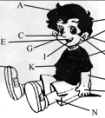词汇考查: 1. Work harder, and you'll make great p________ in your English. 2. Don't knock at the door like that! lt's w________. 3. You're getting heavi-九年级英语
my own house我自己的房子?
如果有两个或两个以上的形容词修饰一个名词时,则由它们和被修饰的名词之间的密切程度而定,越密切的形容词越靠近名词。
如果几个形容词的密切程度差不多则按音节少的形容词放在前面,音节多的形容词放在后面。
2.当形容词所修饰的词是由some,any,every,no等构成的不定代词时,形容词必须置于名词之后。例如:?
She has something new to tell me.?她有一些新的情况告诉我。?
I have nothing important to do today.?今天我没有重要的工作要做。?
Do you know anybody else here??这儿你还有认识的人吗??
3.形容词后面有介词短语或不定式短语时,形容词必须置于名词之后。例如:?
It is a problem difficult to work out.?这是一道难以解决的问题。?
Edison is a student difficult to teach.?爱迪生是个很难教的学生。?
This is a kind of flowers easy to grow.?这是一种易栽的花。?
4.用 and 或 or 连接起来的两个形容词作定语时一般把它们放在被修饰的名词后面。起进一步解释的作用。例如:?
All people,young or old,should be strict with themselves.?
所有的人,无论老少,都应该严格要求自己。?
We are building a new school, modern and super.?
我们正在建一所现代化的高档次的新型学校。?
All countries, rich and poor, should help one another. 所有的国家,无论穷富都应该互相帮助。?
5.有少数形容词,如enough和possible,既可置于所修饰的名词前面也可以置于它所修饰的名词之后。例如:?
Do you have enough time(time enough)to prepare?你有足够的时间做准备吗??
Maybe it will be a possible chance(chance possible)for you.或许它将成为一次可能的机遇。
6.有些形容词,置于名词之前与之后,含义不尽相同。例如:?
the writer present 出席的作者?
the present writer 现在的作者?
7.表示长,宽,高,深,及年龄的形容词,应放在相应的名词之后。
This river is about 100 metres wide.
The building is more than 50 metres tall.
He is less than 40 years old.
8. enough修饰名词时,在名词前后都可以。
They said that they had enough food.= They said that they had food enough.
enough 修饰形容词和副词,位于其后。
He is old enough to join the army.
He isn’t old enough to go to school.
9.形容词else通常放在疑问代词,疑问副词或不定代词后
what/who/where/when/when else
something/anything/nothing…else
What else did you do?
Do you have anything else to say?
10.由两个或两个以上的词组成的形容词词组修饰名词时须放在名词之后。
This is the book easy to read.
这是一本容易读的书。
名词化的形容词:
有些形容词可以和定冠词连用,表示一类人或事物,这时,它相当于一个名词,可作主语或宾语;
表示一类人时,看作复数,表示一类事物时,通常看作单数。
Robin Hooh(罗宾汉) hated the rich and loved the poor.
The old are taken good care of in American.
the+形容词,常见的短语有:
the old/the young/the sick/the white/
the black/the rich/the poor/the dead(死者)
形似副词的形容词:
以-ly结尾的词通常是副词,但是下列词为形容词。
friendly lonely (孤独的) ;lively (活着的);lovely(可爱的)
复合形容词的类型:
(1)名词+过去分词 man-made satellite 人造卫星
(2)形容词+现在分词 a good-looking man
(3)形容词+名词 second-hand cars
(4)数词+名词-ed three-legged chairs三条腿的椅子
(5)数词+名词 400- metre race
(6)副词+现在分词 hard-working students
(7)副词+过去分词 well-known writers
(8)形容词+形容词 a dark-red jacket
(9)形容词+过去分词 ready-made clothes 成品服装
含有形容词的常用句型:
(1) It’s+adj. of sb. to do sth.
(good/ kind/nice/polite/clever/foolish… )
It’s very kind of you to help me.
(2) It’s +adj. for sb. to do sth.
(difficult/easy/hard/dangerous/usefulinteresting/important…)
It’s important for us to learn English well.
(3)下列形容词后常跟动词不定式
表示情感或情绪的形容词:glad,pleased,sorry,sad,afraid,thankful…
I'm glad to see you.
表示能力,意志或推测的形容词:ready,able,sure,certain…
I’m sorry to hear that.
某些现在分词和过去分词可作形容词
the moving story 令人感动的故事
a moved boy 一个被感动的男孩
a frightened child 一个被吓到的孩子
a frightening film 一个恐怖电影
考点名称:实义动词的过去分词
- 过去分词的用法也有两个特点:一是表示完成,二是表示被动。
- 实意动词过去分词变化规律和他的过去式变化规律几乎是一样的:
①一般情况直接加ed,如ask—asked,work—worked
②以不发音的e结尾,只加d,如love—loved,dance—danced
③以辅音字母加y结尾,把y变为ied,如try—tried,study—studied
④以一个元音字母和一个辅音结尾的重读音节结尾的动词,先双写末尾一个字母,再加ed,
如stop—stopped,permit—permitted
注意:以l结尾的动词,尾音节重读时,双写l,如control—controlled,尾音节不重读时,双不双写都可以,如travel—traveled/traveled。
特例:picnic—picnicked,另外还有很多动词的过去分词是不合乎上述规则的,需熟记。 实意动词过去式与过去分词的区别:
过去式是发生过的事;
过去分词形式是发生了并且对现在造成影响的事 。
过去式是用来作谓语的
过去分词用于完成时结构的谓语。
另外,在两者的形式也有所差异,有的过去式和过去分词一样 ,有的不一样 .
比如:
begin began begun 就不一样
teach taught taught 就一样
用的时候一定要分清- 过去分词结构:
1. 过去分词独立结构
过去分词有时可有其独立主语,二者构成一种独立分词结构。过去分词独立结构多用于书面语中,常用作状语,用来表示时间、条件、原因、伴随情况等。如:
He rushed into the room,his face covered with sweat.
他满脸是汗跑进屋来。(表伴随)
This done,we went home.
做完此事,我们就回家了。(表时间)
All our savings gone,the couple started looking for jobs.
积蓄全部用完了,这对夫妻就开始找工作。(表原因)
That point settled,the speaker went on to the next one.
那个问题讲完了,演讲人继续讲下一个问题。(表时间)
2. with/without+宾语+过去分词表示伴随情况的独立结构
With everything taken into consideration,we all think this is a very good plan.
每件事都考虑到了,我们都认为这是一项不错的计划。
With different methods used,different results are obtained.
采用不同的方法,得到不同的结果。
She went angrily away without a word spoken.
她一个字也没说,就生气地走了。
3. 过去分词(短语)作宾语补足语
(1) 过去分词(短语)在感官动词和使役动词等之后作宾语补足语,这些词语有: have 让,使 keep 使处于某状态 get 使得
see 看见 hear 听见 find 发现
feel 感觉到 leave 使处于某状态 make 使
want 想要 start 引起 notice 注意
observe 观察 watch 注视 set 使处于某状态
如:
The work left him exhausted.
这个活使得他筋疲力尽。
The doorkeeper heard the chain and bolts withdrawn.
看门人听见门上的链和拴被拉开了。
The tenant found the house renovated.
房客看到房子已整修过了。
It’s better to leave some things unsaid.
有些事倒是不说的好。
I don’t want my name linked with him.
我不要把我的名字和他联系在一起。
The person concerned should like this matter settled immediately.
当事人希望此事立刻得到解决。
(2)过去分词(短语)在使役动词get或have之后作宾语补足语,表示的动作往往是由别人完成的。如:
I had my car repaired
我把我的车修好了。(别人修的)
I had my hair cut
我理发了。(别人给我理的)
We must get the television set repaired
我们必须把电视机修好。(被别人修)
He had his window broken to pieces.
- 最新内容
- 相关内容
- 网友推荐
- 图文推荐
上一篇:根据句意及首字母提示完成单词。1. We are m______ school students. 2. "Please s______ down," said the teacher. 3. Mr. Wang knows Australia well, because he-七年级英语
下一篇:根据句意及首字母提示完成单词。 1. Are you a m________ school student? 2. Don't s________ under a tall tree when it is raining. 3. My favorite subject is g_-七年级英语
零零教育社区:论坛热帖子
| [家长教育] 孩子为什么会和父母感情疏离? (2019-07-14) |
| [教师分享] 给远方姐姐的一封信 (2018-11-07) |
| [教师分享] 伸缩门 (2018-11-07) |
| [教师分享] 回家乡 (2018-11-07) |
| [教师分享] 是风味也是人间 (2018-11-07) |
| [教师分享] 一句格言的启示 (2018-11-07) |
| [教师分享] 无规矩不成方圆 (2018-11-07) |
| [教师分享] 第十届全国教育名家论坛有感(二) (2018-11-07) |
| [教师分享] 贪玩的小狗 (2018-11-07) |
| [教师分享] 未命名文章 (2018-11-07) |






